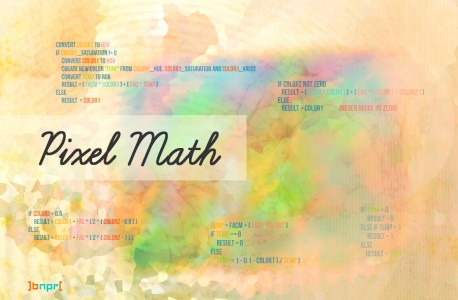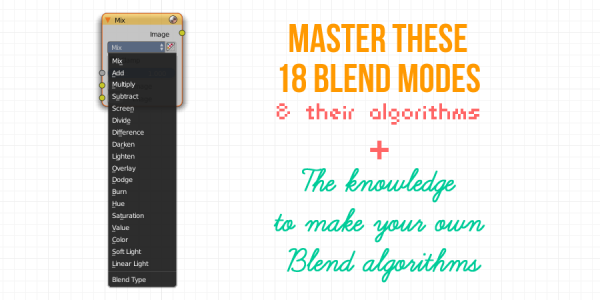The Problems:
Have you been changing blend types in mix node and hoping to get the correct one?
Yes. Even the pros do it in tutorial videos. 😳
Have you wondered how factor differ between the blend modes?
There are differences? Never knew anything about them. 😮
Have you read books or websites explaining about blend modes and wonder about the actual inner working, the algorithms and their limitations?
I have read Wikipedia and other websites, wasting hours. Still learn nothing. I think of the inner working all the time. Blend modes are math, and computers don’t do magic. 😈
Have you ever wanted to make your own blend mode?
Yes. If I’m equipped with the knowledge, I’ll make one and name it with my name. 😆
The Solution:

Pixel Math (noun): Mathematical equations & algorithms which determine color behavior when two or more colors are layered on the same pixel location. Commonly known as blend modes.
Features:
-
Based on real Blender source code.
-
Full algorithms & simplified versions.
-
Explained in easy to understand terms.
-
Nodes examples setup provided.
-
Small ebook with diagrams, fast to read & understand.
-
Quick navigation provided.

Pixel Math Ebook Preview
Extremely beginner friendly.
Learn how each blend mode works.
Learn how factor works in different algorithms.
Discuss which blend modes are useful for which situation.
Outside reference for specific blend modes.
Learn pixel math in the process, it is easy and fun.
Pick up bits and pieces to make your own blend mode.
Node setup working in material and compositor.
Bonus chapter included.

Do it in code, or use the default blend modes, or make your own pixel math node group.
NO MORE wildly scrolling blend modes & hoping that one will come out right. 😉
You can become a Pixel Math Wizard. 😎
Side reading: Background stories of the conception of this e-book
This ebook is not limited to non-photorealistic rendering (NPR). Pixel Math is used everywhere in Blender. For example: render passes are based on pixel math, texture blending, clamping/boosting of high dynamic range image, color grading, tone mapping etc.

Soft Light algorithm in node form
Reviews:
Pixel math is an excellent guide to Blender’s powerful node based shading system. I highly recommend it to everyone interested in real time rendering or compositing. You are not going to find a more complete reference anywhere else. —Todor Imreorov
As both an artist and compositor I would have to recommend “Pixel Math”. Blend nodes have been covered much but never before was I able to read about them in such depth. Clever writing thats down to the point accompanied with plenty of visual guides made this a very easy to read and understand book. Blend nodes are obvious in their behavior when it comes to screen and multiply however when the other nodes are mentioned it opens up a world of possibilities that have never been covered so in depth before. I cannot recommend this book enough since color control and color math are two of the most important things when it comes to understanding pixel math. Blend modes offer power to generate isolations of values that can change the impact of an entire piece. I am honored to have been allowed the opportunity to get to review it also learn from this. Just the reviewing of this book expanded my pixel math to another level and its all thanks to the genius’ over at BNPR. —Jerry Perkins a.k.a MasterXeon1001
A handy reference of color blend modes in Blender, this small ebook explains in simple words all the math equations that govern different ways of blending colors. The book will be a good source of information for anyone who has experience of getting mad with color blending options in the compositor, material nodes, and Freestyle line color modifiers. — Tamito Kajiyama a.k.a T.K.
![]()
Blend On & Do Pixel Math
Specs: Delivery: Online | Size: ~4MB | Format: True PDF
Page Count: 102 | Difficulty: Beginner to Advance
![]()
Note: Please open the “Buy Now” link in a new tab for secure purchase.
